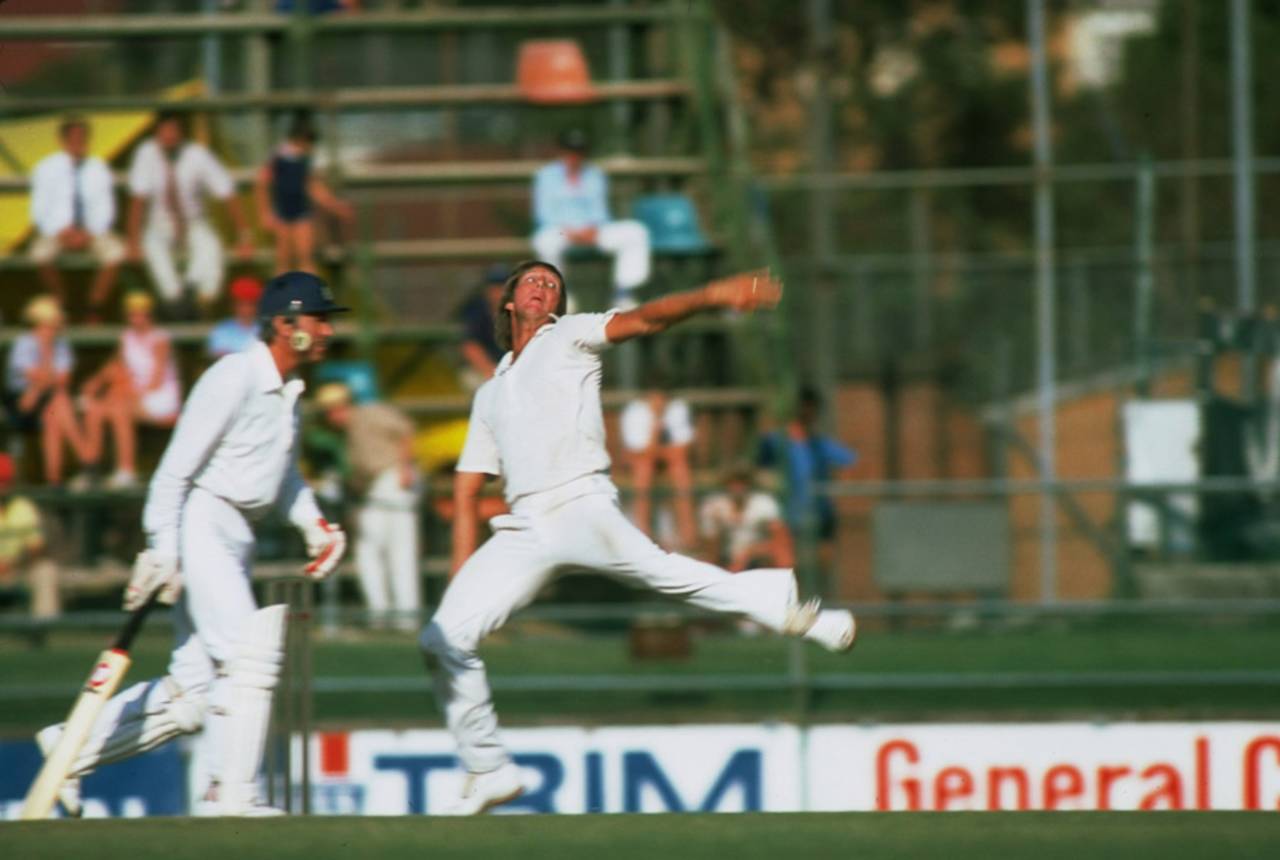Hard to make 'em like Thommo and Typhoon
Though the game has had many quality fast bowlers, none have been quite as lethal as Jeff Thomson and Frank Tyson
Ian Chappell
04-Oct-2015

"Ah mate, I just shuffle up and go whang" • Adrian Murrell/Getty Images
As a 11-year-old I could imitate Frank "Typhoon" Tyson's action, minus the blistering pace and the extraordinarily long run-up. (I only warmed to cross-country running a few years later.)
Tyson decimated Australia in the 1954-55 Ashes series, and where I had previously copied the actions of Ray Lindwall and Keith Miller in the backyard, Tyson suddenly captured my imagination. Talking to Miller and Richie Benaud years later, they said Tyson was the fastest bowler they'd seen.
In the mid-1950s Miller was asked to help a young Sydney grade team fast bowler with his action. After viewing three deliveries in the nets Miller wandered over to the young man and shook his hand. "Ahem, don't worry about being side-on son," Keith offered, "you've got something not many bowlers have - terrifying pace. Good luck Gordon."
He was soon to be Australia fast bowler Gordon Rorke, and after telling me the story, Miller added: "I only saw three men with that sort of pace - Rorke, Tyson and Jeff Thomson."
Coincidental, then, that in the week Tyson passed away I got a phone call from Thommo, who is in Mumbai, where he's doing some coaching - and where Tyson also ran an academy for a number of years.
Thommo and Tyson had blistering speed in common but they were vastly different characters. One speaks with a laconic Australian twang and a liberal sprinkling of colourful adjectives, while the other was a Durham University graduate whose articulate conversation hinted at elocution lessons and nights poring over the Oxford dictionary.
The fact that no Indian fast bowler has come close to emulating the devastation caused by Tyson and Thomson, suggests the entrepreneurs who enlisted the services of those two bowlers are supreme optimists
It's an unorthodox but inspirational choice to woo both to India to coach youngsters in the demanding task of fast bowling. Pace of the sort Tyson and Thomson unleashed is inherent rather than learned, but their views on the subject of fast bowling are worth listening to. They both espoused common sense in talking about fast bowling. When I asked Tyson what was the most important ingredient, he replied, "You need to be a good athlete to bowl fast."
When someone asked Thommo to describe his action, he painted the perfect picture: "Ah mate, I just shuffle up and go whang."
Thommo certainly lived up to Tyson's image of a fast bowler: he was a tremendous athlete. He could run like the wind - he did everything at full tilt - and his unorthodox but extremely practical action was based on an approach he developed as a junior champion javelin thrower.
For his part, Tyson had to be an athlete to run as far as he did - think Michael Holding and then add a few paces - but he was also strong as a bull, with broad shoulders and a barrel chest.

Frank Tyson believed every fast bowler had to be a good athlete first•Getty Images
It's mystifying that no one since has been quite as lethal as those two tearaways. In the interim there have been plenty of good, really quick fast bowlers but no one has created such mayhem in a short space of time. If you compare Tyson's short career with Thomson's peak years - after his debut with a broken toe and before his busted shoulder - the statistics are eerily similar. Tyson took 76 wickets at a strike rate of 45 and Thommo 78 at 46.
For the bulk of their careers the two tormented batsmen who weren't wearing helmets. What the stats don't show is the broken fingers, toes and the battered psyches of batsmen who, if asked about their career choice, would've wondered why they didn't opt for life as professional archers.
The fact that no Indian fast bowler has come close to emulating the devastation Tyson and Thomson caused suggests the entrepreneurs who enlisted the services of those two bowlers are supreme optimists. Perhaps those who engaged Dennis Lillee and Glenn McGrath as coaches at the MRF academy are being more realistic in their aspirations for Indian fast bowlers.
Nevertheless, you can't blame the former for trying. Witnessing the damage - both actual and psychological - that Mitchell Johnson inflicted on the England batsmen who were wearing helmets and protective padding, it's plain to see the advantage to any team in possessing a bowler of genuine pace.
Former Australia captain Ian Chappell is now a cricket commentator for Channel 9, and a columnist